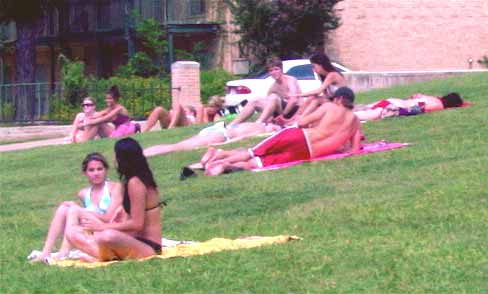The Texas State tanner
By Cheryl Jones
September 20, 2007

Texas State students relax by the river on a Sunday afternoon.
Living in Texas doesn’t help when trying to keep your skin healthy and youthful looking, but there are helpful tips and informative data that can prolong your youthful look and still keep your body healthy with a vibrant glow.
Many students are aware of the dangers ultraviolet rays can cause, but for many those dangers are not pressing when the effects do not show until later in life.
“I do like to sit out in the sun sometimes but I don’t like to be sunburned; I have a history of skin cancer in my family. Even so, if I tanned easier I’d probably go out and tan more often,” said Shanna Crowell, a Texas State University-San Marcos family and child development/ psychology sophomore.
Being tan is one of the fashion statements of the year and whether one goes to the river, tanning salon or uses the subtle enhancers, the bronze look is a craze.
“I like the way I look when I’m tan. It makes me feel good about the way I look,” said Julie Bernhard, a senior mass communication student at Texas State.
According to the Food and Drug Administration, a controlled amount of sunlight is healthy. The sun’s UV rays produce vitamin D, which is necessary in maintaining a normal blood level of calcium and phosphorus in the body and in turn builds strong bones. FDA suggests being out in the sun for a maximum of 15 minutes, twice a week with a follow-up of sunscreen.
The trouble arises when students spend hours at a time soaking up the sun. Laying-out can cause many problems for anyone. Sun exposure can result in thick, leathery skin, wrinkles, discoloration (freckles), a decrease in firmness, tone, broken capillaries and of course the ever-present threat—cancer.
“When I’m at the pool I like to go swimming not just lay there and do nothing,” said Zach Brady, a Texas State anthropology senior.
In order for these types of results to not occur, doctors prescribe their patients to apply sunscreen daily throughout the entire year. The skin has the necessary moisture it needs and you are always prepared for sun exposure. Students are also highly encouraged to go for cancer checkups at least every two years and do personal skin examinations frequently.
Going to the tanning salon produces less UV rays but cancer can still occur. Dermatologists say the only truly safe tanning regime is a tan in a bottle.
Helpful Links:
Revolution Health Group offers a deeper discussion of how the sun damages the skin and Joint Canadian Tanning Association offers an interesting overview of tanning and offers a good illlustration of how the sun penetrates the skin.
New Scientist has another great illustration of the skin.

Students soak up the sun.
